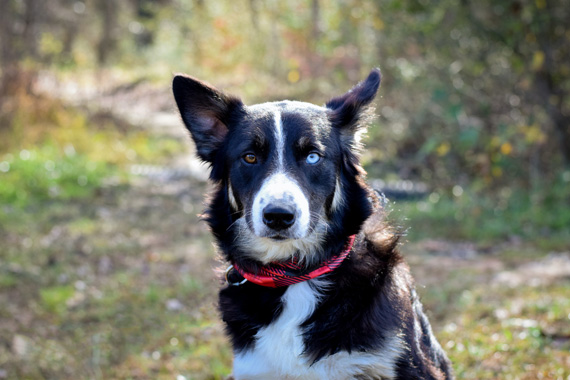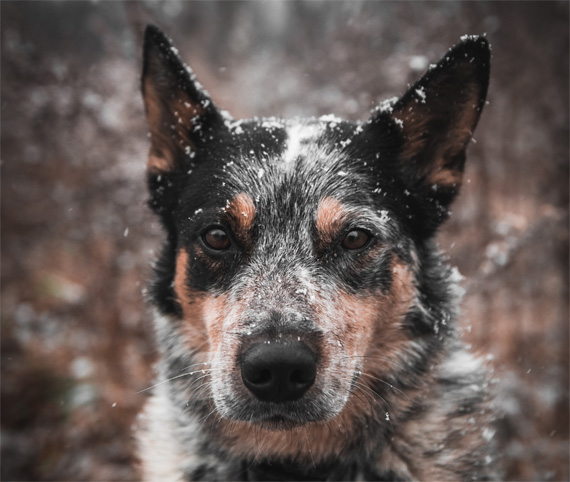Today’s photo tip is about pet portraits and how to get the animal’s attention. Pet portraits can be some of the most fun photography you do. As an added bonus, it’s a great photography training ground.

Photo by Katie Bernotsky; 50mm, ISO 800, f/4.5, 1/1000s.
“Never Work With Kids or Animals!”
Or so says the old show business expression… Why? Because they steal the show every time! While that may be a bad thing for an actor, for us it’s great. We want our pictures to be seen, liked, commented on, and so forth. So, the rule of thumb here is to always include the family pets when you’re shooting portraits. It takes more work, but after you’ve done it a few times you will quickly realize it’s worth the effort. Even better, do shots of each of the kids with their pets. Whether it’s your own kids or you’re doing some photos for a friend, parents love ’em!
But, like everything else, pet portraits have their challenges. You won’t be doing pet portraits very long before you run across a dog or cat that simply won’t cooperate.
Dogs
Dogs are basically pack animals and there is a distinct hierarchy in the pack. Alpha dogs and so on. There is a competition between you as a photographer and the dog to determine who the alpha dog is. Generally, it’s no problem and the shoot goes smoothly, but sometimes you run across a dog that is shy. It is not only content in second spot, but wants to let you be the boss.

Photo by Daniel Lincoln; 23mm, ISO 100, f/1.8, 1/320s.
This becomes a problem because among dogs, eye contact (staring) is the first stage of a fight. The winner of the fight is the alpha. The loser isn’t. A fight can be avoided by one of the two dogs breaking off eye contact and “surrendering.” In addition to breaking off eye contact, they will often lay on their back, exposing the stomach. This is a vital, easily damaged area, and to expose it signals complete surrender.
In your pet portraits, you don’t want a dog that looks like it was just beaten! You want one that looks alert and vitalized. But, the dog sees the lens as an eye staring at them and if it’s a shy dog, to avoid a fight, it won’t look back. There is your “why” a dog won’t look at the camera.
By the way, if the dog has been abused in the past (which is often the case for rescue dogs) you really have your work cut out for you. Allow a lot of extra time to get to know the animal and get them comfortable with you.
Cats
Cats won’t look at a camera for the simple reason that you want them to. They’re obstinate. Cats will be your nemesis. But if you succeed, it’s worth it.

photo by Be Celicious.
Eye Contact
To get pets to look at you, for dogs, sound is the key.
For cats use visual stimuli. As a visual stimulus for cats a peacock feather flicking around the lens will get their attention for a while.
For dogs, get a dog toy with a squeaker in it. Keep it hidden from the dog, and when you are ready to shoot, gently squeak it. This unusual, hard to hear, hidden source of sound will immediately get the dog’s attention! It will look at you, put up its ears, and look attentive. Don’t let the dog see the toy. The longer it takes for it to figure out what is making the sound, the more shots you’ll get. When it starts to lose interest in the squeaking, flick the toy into the air.
Needless to say with both the squeaker and the feather, you have to be ready to shoot the instant the animal looks at the camera. You will only get a split second to capture the ultimate moment.

photo by philhearing
Photographing animals is the best photo training I know to learn how to shoot fast. Give it a try. Animals will drive you nuts, but good pet portraits are definite contest winners!
About the Author:
Dan Eitreim writes for OnTargetPhotoTraining. He has been a professional photographer in Southern California for over 20 years. His philosophy is that learning photography is easy if you know a few tried and true strategies.
Like This Article?
Don't Miss The Next One!
Join over 100,000 photographers of all experience levels who receive our free photography tips and articles to stay current:






Cats aren’t obstinate– they just don’t like being stared at (which is a sign of aggression to them). If you want them to relax, try giving them a few slow blinks before pointing the lens at them, and then give a few more slow blinks when you’re done too.
This is a great post for people who are new (or have some experience) in taking photos of pets.
It’s a lot easier than one thinks, but also a lot harder at the same time.
Thanks for putting this out, you guys!
Have a good one.
/Nabil
Horses – getting their ears up and looking at you – is a chore. I stumbled across a trick: Put an empty plastic water bottle in your back pocket and squeeze it. I mean the crinkly thin walled bottles, not the smart water kind. Beer cans can work too. Or have your assistant or horse owner crinkle the bottle. Works as often as not.
This covers dogs and cats very well – but what about other animals?
I’m trying to shoot chickens – what’s your tips for that?